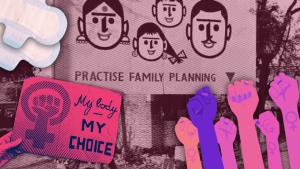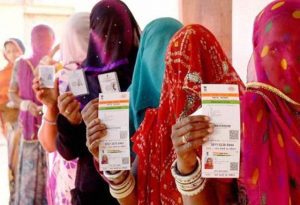Why India’s Abortion Law Still Lacks Principles Of Reproductive Justice

India’s abortion law has evolved over 50 years to become seemingly progressive but it is still not rooted in the idea of reproductive justice, say historians and legal scholars. The reason is that the law is yet to move far enough from its colonial roots that focussed mostly on issues of criminality.
What is the history of India’s abortion law? What are the ideas and policies that informed it at different points of time? In the light of the debate around the US Supreme Court overturning the abortion rights of American women last June, we analyse the evolution of Indian laws on abortion and a woman’s right to bodily autonomy.
In pre-Independence India, abortion was not a concern for the governing colonial authorities unless it led to the death of pregnant women, say historians. “The trajectory of the abortion law in India is rooted in the long history of criminalisation of abortion, and the ideologies behind controlling population through reproductive control,” said historian Mytheli Sreenivas, an associate professor of history and women’s, gender, and sexuality studies at the Ohio State University.
The laws on abortion in colonial India were limited till the procedure was criminalised under the Indian Penal Code, 1860. The code criminalises the act of voluntarily miscarrying or causing a woman to miscarry under Sections 312-315. The law penalises the pregnant mother’s act of voluntarily undergoing an abortion, as well as any person who assists her (medical practitioners or others involved). The law also covers cases where the intentional act of miscarriage is carried out with or without the consent of the pregnant woman, as well as cases where acts intended to cause miscarriage leads to the death of the woman.
“There weren’t many cases of prosecution of persons causing a woman to miscarry that took place under the penal law since the authorities were more concerned with whether the abortion led to the death of the pregnant person. Thus, the legal landscape of abortion in India has been that of criminalisation and that is the colonial legacy we continue to follow. The current abortion law also criminalises abortion with certain exceptions,” said Sreenivas.
Abortion continues to be illegal and punishable under Section 312 of the Penal Code as “causing miscarriage”. The provision punishes both the pregnant woman and any other person who causes her to miscarry if it is done intentionally and without good faith. The act is an offence punishable with imprisonment that may range from three years to seven years. The absolute illegality of abortion continued without any intervention till the 1960s.
In 1967, the Shantilal Shah Committee submitted its report on ‘Question of Legalisation of Abortion’, suggesting that the abortion law in India be liberalised to reduce unsafe abortions and reduce incidents of maternal mortality. The report also pushed for the liberalisation of abortion as a means of family planning and population control.
After this report, the parliament passed the Medical Termination of Pregnancy Act in 1971, to “provide for the termination of certain pregnancies by registered medical practitioners and for matters connected therewith or incidental thereto”. The Act allowed abortion till 20 weeks of the pregnancy under the specified circumstances, and only by registered medical practitioners.
The Act was aimed at granting immunity to medical practitioners in the field of abortion, say legal experts. It was amended in 2002 only to incorporate the use of the then newly introduced abortions pills.
Courts push for change
The most significant amendment to the Act was made in 2021 which focused on increasing the gestational age for allowing abortions – to 24 weeks in exceptional cases. It also increased the scope of the Act by allowing unmarried women also to seek abortions under the law.
Over the last few years, several High Courts have allowed termination of pregnancies in cases beyond 20-24 weeks of pregnancy:
- In July 2022 Kerala HC and Delhi HC allowed termination of 30-week-old and 25-week-old pregnancies respectively,
- In February 2022 Uttarakhand HC allowed termination of a 28-week-old pregnancy, while Calcutta HC allowed a pregnant woman to undergo abortion in the 35th week of her pregnancy,
- In December 2021, a rape survivor was allowed to terminate her 24-week-old pregnancy by the Karnataka HC,
- Prior to the 2021 amendment, in April 2020, the Kerala HC allowed a 14-year-old rape victim to terminate a 24-week-old pregnancy.
In these and other cases, the courts have time and again allowed abortion beyond the gestational limits in exercise of their extraordinary powers.
The apex court, in a landmark judgement in the Suchita Srivastava v. Chandigarh Administration case, 2009, recognised that women’s right to reproductive choices is under the ambit of the right to life under Article 21 of the Constitution. The court reiterated the same in its observations in the 2017 judgement in the case of KS Puttaswamy v. Union of India. Further, in a recent order, the SC observed that unmarried women too entitled to the exceptions, as we reported earlier.
‘Motherhood is seen as the norm’
A rights-based approach requires the state to allow a woman to seek an abortion on demand. It recognises inequalities and obliges the state to frame policies and laws that address these from a human rights perspective.
However, the evolution of India’s MTP Act is rooted in the idea of criminalising abortion, controlling reproductive choices, and population control rather than women’s rights and reproductive justice, say critics of the act.
“The Act was not founded on the idea of a rights-based model of abortion care or the choice of the pregnant woman. The idea of reproductive justice, or even a right-based approach, was absent from the framing of the Act. The law found its genesis in the idea of the state’s control and authority over reproduction which finds itself in the larger idea of family planning and population control policy. Though the MTP Act was not expressly a population control or family planning measure, abortion became a corollary for state control by bringing reproductive healthcare under the family planning policies,” Sreenivas said.
Anupriya Dhonchak, a postgraduate researcher at the University of Oxford, is of the view that the law creates an exception-based regime and has no basis in the idea of reproductive justice or equality. “In such a case, motherhood becomes the default norm and abortion an exception. It allows abortion only if the pregnant person fits into the list of exceptions or if the specified conditions are fulfilled, and up to certain time limits,” she said.
One of the exceptions allowed for a late abortion is a foetus with congenital abnormalities and this also raises the spectre of eugenics, an ideology that seeks to regulate human reproduction for homogenous breeding, said Dhonchak.
“The recognition of reproductive rights under the right to privacy in the Puttaswamy judgement acts as a starting point for a right-based approach, but this acknowledgment of the affirmative duty of the state does not go farther than the observation made in the judgement. The law still needs to be amended to incorporate the observations made by the courts.”
Anubha Rastogi, an abortion rights lawyer, pointed to the fact the current law legalises abortion in certain specified cases only to provide immunity to the medical practitioners. “The requirement of medical opinion in allowing abortion is reflective of the lack of recognition of the right to abortion under the Indian law,” she said.
Not kept pace with changing times
Over five decades, India’s abortion law has made some progress in terms of legalising the procedure, increasing the gestational limits for it, and encompassing unmarried women under the law. But more needs to be done, say experts.
“In the last 50 years, there have been merely two amendments to the law. Cases before the courts have led to relief in those particular cases, thus the rationale that formed the basis of the law five decades ago does not hold true anymore. But the law has failed to keep up with the changing times in terms of the observations made by the courts in reference to the right to privacy, right to bodily integrity, and right of reproductive choices,” said Rastogi.
Courts across the country have passed progressive judgments but these came in cases presented under dire circumstances wherein petitioners were seeking an abortion and the courts granted relief. Only limited steps towards a right-based regime have been taken, says Dhonchak.
Control over reproductive choices
The reproductive choices of women continue to be controlled by the state through the imposition of processes, criteria under the law, and the need for approval from external personnel or boards, said Dhonchak.
“Even though the Act aims to liberalise abortion, the fact that a medical practitioner or a medical board’s approval is mandatory to seek abortion takes away any form of decisional autonomy of the woman over her own body. A woman cannot get an abortion just because she does not want to continue with the pregnancy” said Dhonchak.
The mandates of the law to seek abortion act as methods of control over not just women’s reproductive choices, but also over their sexual autonomy, says Dhonchak. For example, when a woman conceives during sex outside marriage, the law does not guarantee all the rights because the relationship is stigmatised. “This reflects in the state’s paranoia over women exercising their sexual autonomy. This also percolates to the context of an abortion where the personnel involved in giving medical opinion have deeply patriarchal notions about sex outside of marriage and abortions by single women,” she said.
The setting up the regulatory frameworks and the insistence on non-state bodies like medical boards and courts deciding on abortion issues is actually an indirect expansion of state control over women’s bodily autonomy, says Sreenivas. “In a country like India where abortion care is not rights-based, there automatically appear these control mechanisms around who can access abortion and when. The regulatory apparatus then goes beyond what the laws or courts require. Like, the medical practitioners’ or boards’ approval in itself acts as an obstacle, which is further made difficult by the possibility of stereotypes and morals governing their decisions on a case-to-case basis,” she said.
Global Comparison
Canada, Russia, Kazakhstan, Australia, Sweden, Norway, and many European countries have the most liberal abortion practices – the state does not post any conditions for accessing an abortion in these countries, as per the report of the World Population Review. Most of them recognise access to abortion as a part of the larger reproductive rights regime.
While 26 countries around the world including Egypt, the Philippines, Nicaragua, Palestine, and Suriname, completely prohibit abortions, others provide several distinct conditions under which they can be accessed, as reported by the Center for Reproductive Rights. Other grounds for allowing abortion include saving the life of the woman (39 countries), preserving health (56), on social or economic grounds (14), and on request but with varying gestational limits (67).
In countries where abortion is available on request without taking into account other grounds, the gestational limits range from 90 days to 24 weeks. These limits can be increased in some exceptional cases like that of survivors of sexual violence.
“While doing a global comparison of the abortion laws, we should focus not on which countries have higher gestational limits. Rather, the focus should be on whether any nation’s abortion laws find roots in the frameworks of reproductive rights and justice. Like, India on paper has one of the more progressive and liberal laws on abortion, and there are relatively fewer countries that would have a similar abortion law. But the fact remains that in reality, abortion is still not a reproductive right recognised by the law. And the same holds true for several other countries that have seemingly liberal abortion laws but the access is state-controlled,” said Sreenivas.
She pointed to the recent reforms in Latin American countries such as Argentina which are largely Catholic but where social and feminist movements have managed to push back against restrictive abortion laws.
We believe everyone deserves equal access to accurate news. Support from our readers enables us to keep our journalism open and free for everyone, all over the world.




